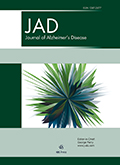Authors: Deng, Chengeng | Cai, Qingyuan | Zhang, Jiani | Chang, Kexin | Peng, Tiantian | Liu, Xiaoge | Cao, Feng | Yan, Xinyuan | Cheng, Junshi | Wang, Xu | Tan, Yan | Hua, Qian
Article Type:
Research Article
Abstract:
Background: Presenilin (PSEN, PS) is essential for γ-secretase function, and mutations can disrupt amyloid-β (Aβ) production in familial Alzheimer’s disease. Targeting γ-secretase is complex due to its broad involvement in physiological processes. Objective: Our aim was to create a novel knockin (KI) mouse model expressing PSEN1 D385A mutation and investigate the efficacy of a Geniposide and Ginsenoside Rg1 combination (NeuroProtect modified formula, NP-2) in restoring γ-secretase activity. Methods: Using gene manipulation, we established the PS1 D385A KI mouse model and confirmed the mutation, mRNA, and protein levels using Southern blotting, northern blotting, and western blotting, respectively.
…In vitro γ-secretase assay was conducted to measure γ-secretase activity, while histological analyses examined neurogenesis effects. NP-2 administration evaluated its impact on γ-secretase activity. Results: The PS1 D385A KI homozygotes displayed severe cerebral hemorrhage, postnatal lethality, developmental disorders, reduced proliferation of neural progenitor cells, and disrupted γ-secretase function. The mutation abolished PS1 protein self-shearing, leading to compromised γ-secretase activity. NP-2 intervention effectively restored γ-secretase activity in the heterozygous mice. Conclusions: PS1 D385A mutant disrupted PS1 protein self-cleaving, impairing γ-secretase activity in KI mice. NP-2 restored γ-secretase function, offering potential for novel AD treatment strategies despite the challenges posed by γ-secretase’s complex role in physiological processes.
Show more
Keywords: Alzheimer’s disease, amyloid-β, D385A, geniposide, ginsenoside Rg1, presenilin, γ-secretase
DOI: 10.3233/JAD-231148
Citation: Journal of Alzheimer's Disease,
vol. Pre-press, no. Pre-press, pp. 1-17, 2024
Price: EUR 27.50





